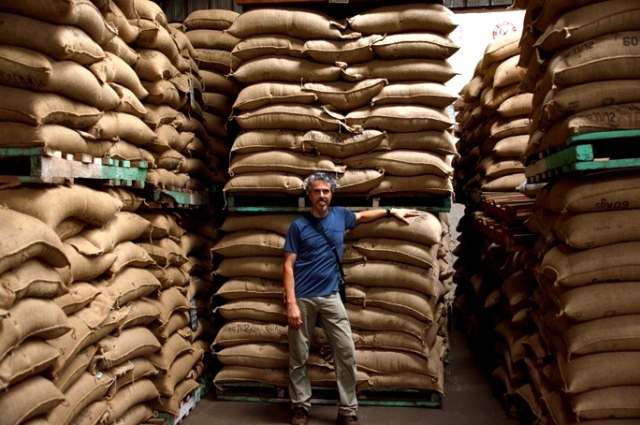Coffee, Cocoa, Sugar, Rubber and Gold Prices Start Rising in London Market.
By TZ Business News Staff and Agencies.
The Month of April, 2015, has brought with it hope for commodity prices, according to media reports.
The Iraqi Oil Minister Adel Abdel Mehdi predicted earlier in the month world oil prices could rebound to $70 a barrel by the end of 2015. The movement of the price is proving the minister could be right months away from the predicted time frame; and virtually all commodity prices are rising.
Star commodity performer oil surged in value last week on hopes that easing US shale output could help curb the stubborn global supply glut, analysts have said, according to a report published by the Middle East & North Africa Financial Network (MENAFIN).
“Oil prices rose sharply in the past week, supported by further evidence that US production and crude stocks are close to peaking-if they have not done so already,” said Julian Jessop, head of commodities research at the consultancy Capital Economics.
By Friday of the week ending April 18, 2015 on London’s Intercontinental Exchange, Brent North Sea crude for delivery in June rallied to $ 64 a barrel, up from $56.84 for the May contract the previous week. On the New York Mercantile Exchange, West Texas Intermediate or light sweet crude for May leapt to $56.12 compared with $50.80 in earlier trading.
The sharp rebound contradicts convictions among a number of US analysts who have not been able to see this climb even before mid-year. Oil prices have fallen as much as 50% since mid-2014 on the back of copious global supplies and weak demand. Many US analysts have predicted the slump could persist for much longer.
“The recent stability of the US dollar has also helped sentiment towards commodities more generally,” the Capital Economics analyst observed.
OIL: Crude futures rallied on signs that US shale oil production-a key driver of the stubborn supply glut that sparked collapsing prices-may be on the cusp of easing.
The Organisation of the Petroleum Exporting Countries (Opec) predicted that US crude production would fall in the final half of the year, reducing the global oversupply.
“Higher global refinery runs, driven by increased seasonal demand, along with the improvement in refinery margins, are likely to increase demand for crude oil over the coming months,” Opec said in its monthly oil market report.
“Given expectations for lower US crude oil production in the second half of the year, these higher refinery needs will be partially met by crude oil stocks, reducing the current overhang in inventories.”
Carl Larry, an analyst at Frost & Sullivan, said that the market appeared to be trending higher, which could bring prices back up to the 65-70 range, thanks to a rebalancing of supply and demand.
“We’re starting to see refineries run higher,” Larry said. “We have a lot of refining season to go-we just got started-we are going to start seeing more drawdown in crude, we are going to start seeing production start to tip off.”
Prices diverged on Friday as traders locked in profits following a six-day rally.
“After a sustained increase in both the WTI and Brent over the past week, traders are selling… and this has led to the downward pressure in prices we see today,” said analyst Daniel Ang at Phillip Futures in Singapore.
But Ang said the oversupply was unlikely to end soon due to strong Opec production levels.
The 12-member Opec, which pumps around a third of the world’s oil, saw its production in March rise by 810,000 bpd to average 30.79 mbpd, Ang said.
WHAT’S GOING ON IN THE US?
The crude oil contango market in the U.S. has created a massive incentive to store oil and, while traditional storage hubs reach record high levels, Genscape analysts have identified a trend for operators to look to their own wells as an avenue to store until commodity market conditions improve (March 30, 2015, Wall Street Journal).
Already, over 800 wells are being deferred by Cabot, Chesapeake, EOG, SM Energy, Apache, and Anadarko alone, accounting for about 373 Mb/d of oil and 528 MMcfd of gas according to Genscape analysis.
Genscape economic models indicate the oil price decline to $45 on WTI has priced out the majority of the Eagle Ford and Bakken oil plays, except for the very cores of the plays, 4traders.com has reported.
Besides completion deferrals, rig counts are expected to decline further based on the forward curve, and this expectation is supported by Genscape’s economic findings reported in Oil and Gas Production Forecasts.
EOG Eagle Ford is one of the companies monitored by supply-side experts at Genscape, and it’s also positioned in the core of the Eagle Ford play.
“With today’s prices, EOG’s returns are marginal given the uncertainties, and payback is either 46 months with an IRR of 16 percent, or never and -2 percent IRR if the $45 WTI price were to persist,” says Randall Collum, managing director of supply side analytics at Genscape. “Deferring completions and receiving the improved pricing in the forward curve not only saves them capital this year, but would pay back the well investment slightly faster.”
Understanding and accounting for well completion deferrals is emerging as a critical element to gain a complete understanding of today’s market drivers. Genscape’s complimentary white paper detailing the market conditions leading to the trend to defer wells, as well as the reactions of specific companies, is available.
Genscape analysts have developed additional detail behind the shale play breakeven analysis with the key operators analyzed within proprietary models. In the Bakken, Eagle Ford, Marcellus, and Utica alone (four key areas of oil and gas growth), Genscape has compiled 108 different operator play economic models to calculate breakeven prices and to delve deeper into understanding drilling and completion economic drivers.
Using a bottom-up approach that accounts for well economics, Genscape’s forecasting models for oil and natural gas are integrated with the forward price curve so reports adjust to market conditions.
IRAQI MINISTER SAW IT COMING…
In March, 2015, Iraq’s Oil Minister Adel Abdel Mehdi predicted world oil prices could reach 70 a barrel by the end of 2015 and played down the impact of the emerging conflict in Yemen on prices.
A global slump in oil prices has slashed government revenue in Iraq prompting the OPEC producer to renegotiate contracts with oil majors as it faces a costly military campaign against Islamic State militants.
‘In January prices reached the bottom and they can’t go any lower than that’ Abdel Mehdi told Reuters in an interview on Thursday. ‘Now they’re going up slowly but steadily. They will go up and maybe reach 70 by the end of the year’.
Brent oil rallied for a second straight day on Thursday to more than 59 a barrel after Saudi Arabia and its Gulf Arab allies launched air strikes in Yemen sparking fears of a wider regional confrontation that could disrupt world crude supplies.
But Abdel Mehdi said the impact of Yemen on crude prices would be short-lived: ‘Of course political issues such as the crisis in Yemen can give some push to the ascending line of prices but it will have temporary effect.’
The fall in world oil prices means Baghdad is now paying companies much more than it would be under the production-sharing model followed elsewhere and is seeking to renegotiate the terms of its contracts.
International firms operate in Iraq’s southern oilfields under service contracts currently based on a fixed dollar fee for additional volumes produced ” a formula which has seen Baghdad’s bills balloon just as its oil revenue collapses.
Abdel Mehdi said he had met with Royal Dutch Shell on Thursday to discuss amending its contract favourably for both sides but stressed that nothing had been finalised with the major or any other company. ‘We are still really in the negotiation stage. Nothing has been signed yet with any of the IOCs’ he said.
Abdel Mehdi said any revision of contracts would not result in major changes to the deals or their structure and that a production target of 9 million barrels by 2020 remained firmly in place. ‘We stick with our schedules’ he said.
Iraq currently exports 2.9 million barrels per day (bpd) of oil and Abdel Mehdi said the average for March was on track to hit 3 million bpd.
The oil minister said Iraq would try to repay oil companies the 9 billion of payments they are still owed from 2014 by lifting crude from Kirkuk or Basra before the end of June.
Asked whether Iraq was concerned about the possible return of Iran to the oil market in the event a deal was reached between Iran and world powers on the nuclear issue Mehdi said stability in the region was the most important thing.
‘The gains will be much greater if we have succeeded negotiations between 51 with Iran’ Mehdi said even though if sanctions were lifted on Tehran’s oil sales supply would increase putting downward pressure on prices.
OPEC is due to meet in June and Abdel Mehdi said he saw no sign Saudi Arabia would reduce production: ‘I don’t think they have the intention of doing so. I think they are defending their market share’ he said.
COMMODITY PRICES RISING…
PRECIOUS METALS: Gold climbed as uncertainty over Greece’s potential eurozone exit sent investors into the safe-haven commodity. “Escalating worries that Greece will default on its debt and the ultimate decision surrounding its inclusion in the eurozone has helped squeeze gold higher as the precious metal once again breaks above the 1,200 level,” said IG analyst Alistair McCaig.
By Friday on the London Bullion Market, the price of gold climbed to 1,203.35 an ounce from 1,182.75 the previous week. Silver firmed to 16.36 an ounce from 16.30. On the London Platinum and Palladium Market, platinum dipped to 1,161 an ounce from 1,205. Palladium was unchanged at 777 an ounce.
BASE METALS: Base or industrial metals diverged, but tin slumped on oversupply fears.
“The tin price has fallen (to) its lowest level since September 2009,” said Commerzbank analysts. The sharp drop was “due to fears of an oversupplied market after China scaled up its production in the first quarter and because significantly more tin is reaching the market. “The downward movement is likely to have been exacerbated by sell orders from speculative financial investors.”
By Friday on the London Metal Exchange, copper for delivery in three months rose to 6,079 a tonne from 6,025.50 the previous week. Three-month aluminium advanced to 1,837 a tonne from 1,766.50. Three-month lead increased to 2,043.50 a tonne from 1,998.50. Three-month tin tumbled to 15,100 a tonne from 16,570. Three-month nickel increased to 12,745 a tonne from 12,680. Three-month zinc edged higher to 2,223 a tonne from 2,203.50.
SUGAR: Prices recovered further from the commodity’s recent slide close to six-year lows. By Friday on LIFFE, London’s futures exchange, a tonne of white sugar for delivery in August gained to 375.10 from 366.10 a week earlier. On ICE Futures US, unrefined sugar for July increased to 13.22 US cents a pound from 12.45 US cents.
COCOA: Futures rebounded despite ongoing concerns for world demand. By Friday on LIFFE, cocoa for delivery in July climbed to 1,979 a tonne from 1,974 the previous week. On the ICE Futures US exchange, cocoa for July rose to 2,875 a tonne from 2,804.
COFFEE: Prices posted modest gains. By Friday on ICE Futures, Arabica for delivery in July rose to 142.55 US cents a pound from 136.70 cents the previous week. On LIFFE, Robusta for July gained to 1,832 a tonne from 1,799.
RUBBER: Prices rose on keen demand. By Friday, the Malaysian Rubber Board’s benchmark SMR20 rose to 139.85 US cents a kilo from 136.90 US cents a week earlier.






